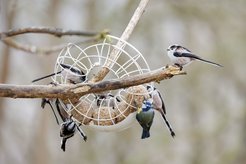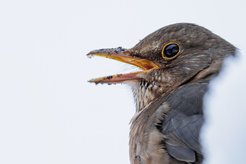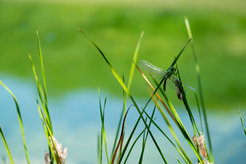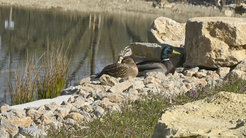
Biotope Blog 2022
December 20, 2022
Feeding our birds in winter

Opinions differ on the when and how to feed birds. There are good arguments for each side. We feed them all year round – as ornithologist Peter Berthold recommends. Now in the cold season as well as during breeding season, we observe the greatest rush at our bird feeder.

What do we feed?
After trying out several types of food, we found the following mixture to be an all-time favorite:
- peanuts (whole and chopped)
- sunflower seeds (with shell, peeled, and chopped)
- edible fat
- fat food
- milo
- millet
- corn grits
- oat kernels
- hemp
- mealworms
In addition, we provide energy blocks and fat balls. We always feed fat balls WITHOUT a net, since birds can receive serious injuries by tangling their legs.
How do we feed?
We offer the food mixture in a large sheltered feeder that was built by our carpentry. Such feeders are often said to be unsanitary and to promote the transmission of diseases. We therefore clean our feeder regularly to counteract such risks.

Who digs in?
In recent weeks, we have observed mainly great tits, blue tits, willow tits, marsh tits, blackbirds, crows, chaffinches, nuthatches, and great spotted woodpeckers at the feeder. Even a green or gray-headed woodpecker (it disappeared too quickly before we could clearly identify it) plundered the buffet.
To feed or not to feed?
Our guests are mostly common, non-endangered species. We hardly ever encounter rare and endangered bird species at the feeder, though. Critics of bird feeding see the danger that common species will gain a competitive advantage and that rarer species will be pushed back even further.
Proponents of bird feeding argue that the environmental conditions for our birds are bad enough, so it is important to protect each individual animal. We see it the same way.
More information
Here you can find a great informational video on the topic: The Right Way on How to Help Birds During Winter - YouTube
Our tips and tricks around bird feeding, but also around creating your own biotope can be found here:
DIY Biotope | Max Planck Institute for Multidisciplinary Sciences (mpg.de)
December 7, 2022
Ecological mowing

To ensure that the bloomage of our wildflower meadows, which we established in 2020 and 2021, lasts for a long time, they must be mowed properly – and initially twice a year. This allows short-lived species to persist longer, encourages annual flowers to self-seed, and keeps grasses from becoming too dominant.
Recently, for the first time, we had our wildflower meadows cut back with an environmentally friendly bar mower. With its low mowing speed, insects are harmed much less and can escape more easily. In addition, thanks to a clean cut, bar mowers hardly injure the individual plants.

In addition, it is also important to remove the mown material immediately. This is because plant residues that are not cleared away after mowing rot and form a nutrient-rich humus. This would make the soil undesirably “rich”. On sites that are too rich in nutrients, grasses spread and push back wildflowers.
The mowing work was carried out by an external company from the region. So far, however, there are not many companies that have ecological mowing as part of their repertoire.
November 29, 2022
Birding tours through the BioDiversum
For the second time this year, interested employees were drawn to explore the biotope. In the early morning hours, they listened with open ears to the voices, singing and chirping during a guided birding tour. Well-equipped with warm clothing, sturdy shoes and some binoculars, they encountered all kinds of birds – from hawfinches and black woodpeckers to bullfinches, chaffinches and fieldfare.
The tour guides were colleagues who, as experienced amateur ornithologists, are happy to share their knowledge with other bird enthusiasts. After both excursions, all participants were enthralled, so that regular bird tours by and for employees through the BioDiversum will also take place in the future.
If you want to learn more about the first birding tour, find here a link to an article in our institute magazine INSIDE NAT.

September 13, 2022
Biotope Cinema
Lights out, popcorn at the ready, start the movie! Our wildlife camera in the biotope has taken some exciting pictures of animal inhabitants and guests of the BioDiversum over the past months.
In our best-of video, we have compiled this year’s highlights. Badger (Meles meles), European wildcat (Felis silvestris), raccoon (Procyon lotor), and roe deer (Capreolus capreolus) gave impressive performances in front of the camera, which in our opinion are hardly inferior to a cinema blockbuster.
Best of Biotop 2022
Nevertheless, a family of wild boars (Sus scrofa) stole the show from all the other performers with a single brief appearance.
Wild boar family in the BioDiversum
Seven boarlets trot along in single file after their mother, the wild sow. One of the piggies, however, stands out in its appearance: Instead of having light brown fur with yellowish longitudinal stripes – the typicyl coloration of boarlets – it has a light skin and dark spots. Presumably, the pedigree of the sow also includes one or the other domestic pig, whose genes have had an effect on the coloring of the offspring. The little pig should not suffer any disadvantages, though, except for poorer camouflage in the forest.
Since our wildlife film does not follow a script, we are curious to see which forest dwellers will run in front of our lens next. There will certainly be a sequel to our biotope cinema!
August 25, 2022
The little oasis

Surrounded by streets, parked cars, and buildings, our central area at the front of the institute’s premises seems like an oasis. As part of our biotope project, we have fundamentally restructured and ecologically upgraded the small area. We removed shrubs that were not suited to the location, removed gravel areas, and impoverished soil by mixing in sand. Today, our employees and visitors find flowering and fruit-bearing shrubs, herbs, and trees there.
The lower area is strongly exposed to the sun. This is why we have introduced particularly drought-resistant plants, like agastache or oregano, to the delight of many bumblebees and butterflies.
We created a path through the small oasis, which makes the area tangible for the staff. It also allows a short detour into the greenery on the way from the office to the canteen.


August 17, 2022
Master Hare dropped by
A few weeks ago, a visitor jumped in front of the camera that we had not encountered before in our biotope: a European hare (Lepus europaeus). The species is widespread throughout Europe and prefers to live in semi-open areas such as farmlands and meadows, alternating with shrub-rich areas.
As pure vegetarians, they feed on a varied diet of herbs, grasses, cereals, crops, buds, shoots, and bark.
We are happy about the new guest and continue to keep our eyes and ears open for new subtenants and transients.

July 29, 2022
Fauna monitoring in the BioDiversum – First preliminary results

On the basis of regular population surveys, we want to check whether our measures are successful. In 2019, experts determined the status quo of the vegetation and various animal species, including butterflies, wild bees, birds, and bats. As planned, the experts are out again this year. The first numbers are promising:
Eight dragonfly species are now buzzing around our pond and several new butterfly species are fluttering around our wildflower meadows, including the European skipper (Thymelicus lineola), Old World swallowtail (Papilio machaon), and High Brown Fritillary (Argynnis adippe).
Well over 80 species of wild bees have been discovered at the biotope site so far, including twelve predominantly rare species, such as the Hawksbeard Mining Bee (Andrena fulvago), which is still listed as “lost” in Lower Saxony.
Among birds, almost twice as many breeding pairs compared to 2019 were recorded so far. Their number rose from 83 to 159. There was a doubling of the most common species, Eurasian blackcap (Sylvia atricapilla) and blackbird (Turdus merula), as well as significant increases in the cavity nesters great tits (Parus major), blue tits (Parus caeruleus), and nuthatches (Sitta europaea). The red-backed shrike (Lanius collurio) is a new visitor, but has not yet decided to stay.


July 25, 2022
The BioDiversum in the media
In January, we got visited by a journalist who did research for an episode of the German SWR2 Wissen – Podcast.
The topic: The animal and us – the mammoth task of species protection.
Have a look at the interesting article and give the podcast a quick listen. Our BioDiversum also makes an appearance:
The mammoth task of species conservation
A few months later, in May, a student asked if she could make a short video about the our biotope as part of her course “Message in Film” at the University of Göttingen. We were happy about the idea and think the result is really great (German only): Pflanzen, Vögel, Insekten:
Plants, birds, insects: The BioDiversum at the Göttingen Campus
July 14, 2022
Kestrel chicks 2.0


Certainty at last: Our two kestrels raise four chicks again this year. Since April, the parents have been busy courting, breeding, and later feeding. Until recently, our observations were based only on what we heard, that is, courtship and begging calls, because we are not able to look inside the nest box. But now, the chicks are old enough to do flight exercises at the edge of their home and eagerly wait for their parents to bring the next meal.
One youngster already fledged, the others will follow very soon. Then they will stay close to their parents for a few more weeks before they set out to live their own independent lives.
June 2, 2022
Dragonflies hatching
Just as a caterpillar develops into a butterfly, a dragonfly larva grows into a dragonfly. Initially, female dragonflies lay eggs, often directly in the water or on water plants. After a few weeks, the eggs hatch into dragonfly larvae.
These larvae live in the water, where they feed predatorily, for example on water fleas or mosquito larvae. Larger dragonfly larvae also feed on tadpoles and even small fish. During this stage, they molt ten times or even more. The larval period can last from three months to five years, depending on the species. At the end of this phase, the insects seek out elevated, vertical structures on the shore, such as reed stalks or roots. There, the dragonflies hatch out of their larval skin. In a short maturation process, the dragonfly unfolds its wings and lets its skin harden.
Fortunately, we were able to witness the dragonfly hatching live:
Dragonflies hatching in the BioDiversum
The adult dragonflies will live for two to eight weeks. During this time, they mate and lay eggs. The life cycle starts all over again.
May 3, 2022
Twitching and wriggling in the pond

It's been three weeks since we told you about our first toads in the biotope – in the meantime, their offspring has hatched and is now shaking up the whole pond. We discover little tadpoles everywhere, eagerly foraging for plant remains and algae. As soon as they get bigger, small carrion will also end up on the menu.

April 19, 2022
Offspring at the pond

After ducks, newts, flatworms, and dragonflies, we have now spotted common toads (Bufo bufo) in and around our pond. They are by far the most widespread toad species in Europe. Usually they spawn already in the middle of March. This year, however, they had to wait a little longer due to the dry weather. It was not until the rainy days of April that a flock of toads set out for suitable breeding waters. A few of them tried their luck in our new pond. After spawning, the adult toads exit the water and leave behind meter long, densely packed egg strings. Depending on the water temperature, tadpoles develop after a few days. After two to three months, they have grown into young toads that head out into the big, wide world.

We keep our fingers crossed that our first tadpoles in the BioDiversum will develop well. However, our young pond still lacks hiding places as its aquatic plants are still growing. It will thus not be easy for the toad offspring, but not impossible either.
April 5, 2022
MPI-NAT… NAT… NAT…

Twice they visited us, twice we unintentionally scared them away with our enthusiasm (and our cameras): A pair of ducks has discovered the pond in our biotope! The pond still lacks food and vegetation to keep them on the Fassberg for longer. We hope that in the next few years it will be transformed into a habitat for ducks – and other water loving animals of course–, so that they do not only drop by for a flying visit!

March 28, 2022
All! These! Nests!
... are the result of cleaning our nesting boxes in the last weeks. 41, that is the yield of one year after setting up almost 100 boxes. From our observations, we even know that some bird couples bred twice in their nests. Most of the nests were most likely built by great tits, blue tits, and a few nuthatches.

By the way – for these two reasons you should clean your nest boxes either in late summer or toward the end of winter:
1) Birds don’t dispose of old, abandoned nests. Instead, the next inhabitants simply build their new nest on top of the old one. As a result, the next brood is always closer to the entrance hole, making the hunt easier for predators.
2) In addition to dirt, there are always parasites and pathogens in the nest boxes, which can endanger the brood in the coming year.
For 2022, we expect a greater run on our nesting boxes. That is because last year we were late in hanging some of the boxes. Now, however, the birds had plenty of time to familiarize themselves with the housing market. We are particularly curious to see whether our tree creeper boxes will be accepted. They have only been hanging since late summer.
March 8, 2022
Pond construction in fast forward
Building the centerpiece of our biotope was a major undertaking. From March to October 2021, the diligent construction workers were plowing, digging, dredging, and planting. We filmed all the hard work and don't want to deprive you of the 2-minute video of our pond’s creation. Next to the construction site were our alpacas: Aren't they cute, how they munch their way over the meadow in fast motion?
BioDiversum in 2 minutes
If you want to see more details, you can find them in the long version of the video. Go on a discovery tour and see what it reveals!
- When can you see our alpacas and what weather conditions do they prefer?
- At what time is the water let into the pond?
- When is the opening ceremony taking place?
You can find the answers to these questions here:
January 19, 2022
All-round view at the bird feeder

We recently set up a 360° camera at our year-round bird feeder. We wanted to figure out which guests we were actually hosting. And lo and behold, we actually had a VIP for a visit: A Grey-faced woodpecker (Picus canus) eagerly helped itself to the buffet. We are particularly pleased about this, because the species is considered endangered in Germany. Grey-faced woodpeckers are easily confused with green woodpeckers, which are much more common here.
In the video, our guest of honor bumps into a visitor we hadn't planned on. Take a look:

























